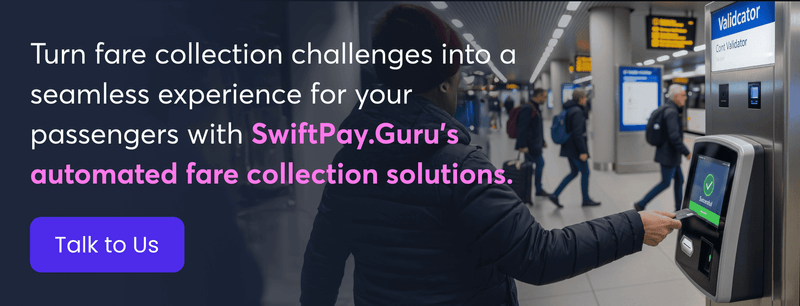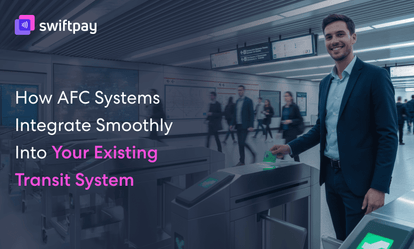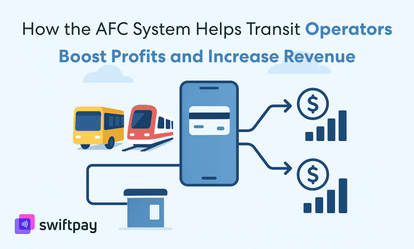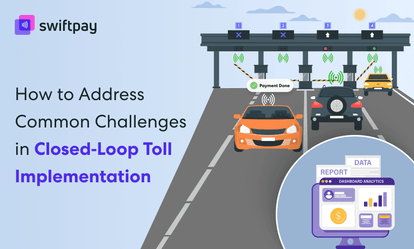Manual fare collection initially seems easy to manage. But over time, it can hold you back. And, it can lead to constant delays, inaccuracies, and even increased mistrust among your passengers.
Whether you run a bus service or manage a city-wide network, manual processes slow everything down.
Using cash, paper tickets, and manual checks means long lines and constant fare disputes.
And when something goes wrong, there’s little visibility to trace or correct the issue.
And, today, your passengers expect better. Your customers want faster boarding, easier payment options, and fewer delays.
Your passengers also want to feel confident that their fare is accurate every time. When your system can’t keep up with those expectations, your reputation can take a hit.
That’s where automated fare collection systems come in.
A closed-loop fare collection system gives you full control over operations, revenue, and the rider experience. With the right system, you see what’s collected, spot what’s lost, and make faster, smarter decisions.
Let’s look at the challenges you face and how automated fare collection helps you solve them.
1: Slow Boarding and Passenger Delays
Slow boarding and passenger delays can frustrate your riders and break their trust in your service, especially when lines form at the bus door. Some of your passengers search for tokens, while another passenger hands over a wrinkled paper ticket. And just like that, boarding becomes slow and frustrating for both your staff and your passengers.
Manual fare collection methods like cash, tokens, and paper don’t just take time; they also create bottlenecks.
And, when boarding takes too long, your entire schedule suffers. And your passengers are not happy about the wait.
Here’s what this looks like in real time:
- Your passengers get stuck at entry points, especially during rush hours
- Delays throw off your schedule and can cause your passengers to miss their transfers.
- Your staff ends up managing queues instead of running service, and
- Your riders complain, or worse, they can stop using your service
Your riders today expect to tap and board without delays. Relying on cash or paper tickets can make boarding feel slow and can frustrate your riders. Over time, your customers get frustrated and stop trusting your service.
2: Human Error and Fare Disputes
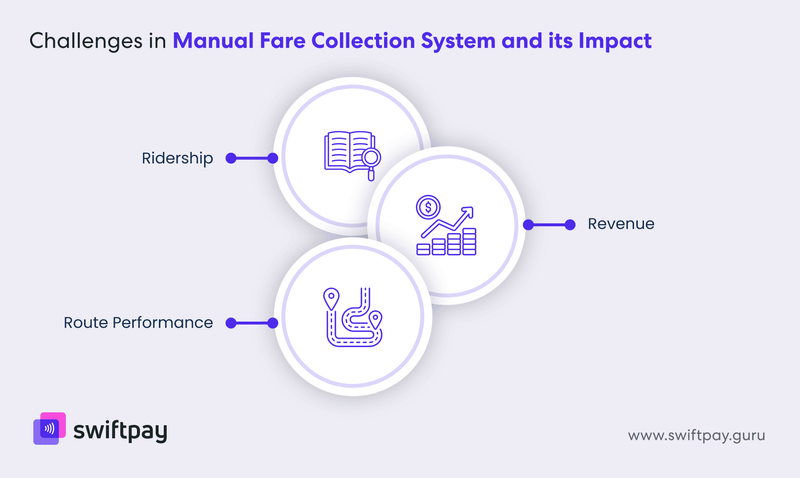
When fares are collected by hand, mistakes happen. Some of your riders pay more while others pay less for the same trip, and there’s no clear way to prove what’s correct. This leads to confusion, complaints, and a loss of trust in your service.
Here’s where manual fare systems often fail:
- Inconsistent charges due to human error
- No way to verify or audit payments
- Your passengers feel overcharged or treated unfairly
- Confusion for first-time riders, tourists, or elderly passengers, and
- Your staff has to deal with dealing with angry complaints that they can’t resolve
It’s not just about lost fares; it’s about trust. Your riders expect clear and consistent pricing, and when fares seem confusing or unfair, they start to doubt your system. Once that trust is affected, it can be difficult for you to regain.
3: No Real-Time Data or Control
Relying on manual fare collection means you’re always a step behind. You can lack real-time insights into revenue, how many passengers are travelling, and route performance, which makes running your service more complicated and less reliable.
Here’s how that shows up day to day:
- No visibility into peak hours, route performance, or passenger volume
- No way to detect losses or revenue leakage quickly
- Poor data for budgeting or adjusting schedules, and
- Limited control over fare policies or pricing experiments
For your passengers, this lack of insight shows up as:
- Overcrowded buses on busy routes
- Long wait times with no explanation, and
- Unreliable schedules that don’t match real demand
If your fare system doesn’t show what’s happening in real time, you’re just guessing. It slows you down and leaves your riders frustrated. And, nowadays, you need clear data to run things smoothly; anything less just doesn’t work.
4: Revenue Loss and Fraud
When you’re still using cash or paper tickets, it’s easy to lose track of how much money you’ve actually collected. You can’t always tell who’s paid or how much, which makes it prone to theft, fraud, or losses slipping by unnoticed.
This leads to:
- Misreporting of fare amounts
- Unlogged transactions, and
- Fare theft that continues without detection
When your system feels unfair, your passengers notice. Some of them stop paying, and others lose trust. And, frequent riders can feel penalised, and your revenue takes a hit.
Without clear fare collection data, it’s hard to plan or make improvements, and these losses don’t just affect your bottom line; they also damage the trust your service depends on, which makes future growth more difficult.
5: Outdated Rider Experience
Your riders don’t want to wait in lines or deal with cash anymore. And, your passengers expect quick, digital check-ins every time.
If your system still runs on tokens or printed passes, it feels outdated. Today’s commuters, especially regular passengers, tourists, and office-goers, look for tap cards, QR scans, or app-based entry. That’s what they have used & what they expect.
If you’re not using an automated bus fare collection system, you’re already behind.
And here’s what your riders are missing out on:
- Mobile apps for fare top-up or recharges
- Trip planning tools that integrate with payments
- Loyalty rewards or programs for your frequent riders, and
- Personalized services based on travel history
You also miss out on valuable data. With no automatic fare collection, you can’t see usage trends or create better experiences.
Additionally, your competitors, including private operators and ride-hailing apps, already use automatic fare collection to attract and retain your riders. They offer smoother, more modern journeys.
And, if your system still feels outdated, your passengers will quietly leave.
A modern automatic fare collection system is not just about tech. Meeting expectations of your riders is key. Your riders want things fast, simple, and under their control, and they won’t accept anything less.
In transit today, convenience wins. If your system doesn’t deliver it, someone else’s will.
Read more: Data Security and Fraud Prevention with Closed-Loop AFC
How Closed Loop Auto Fare Collection System Solves These Challenges
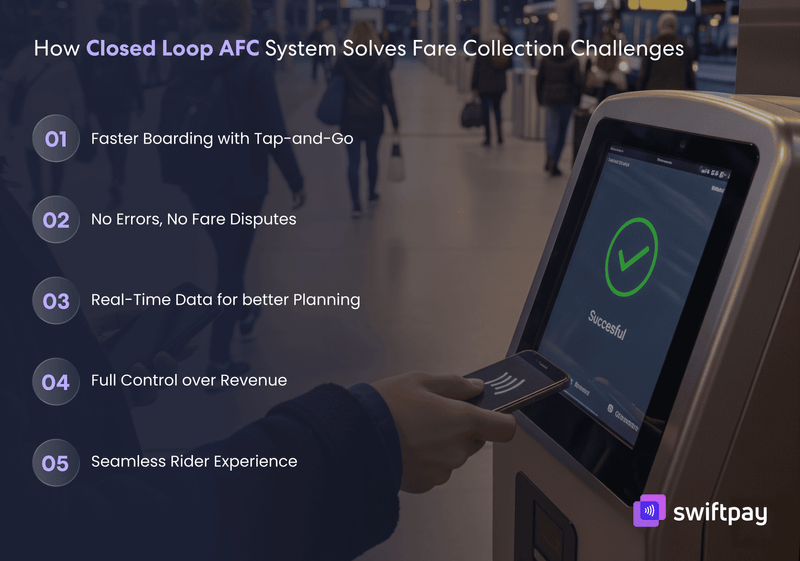
Manual fare systems can limit your growth. Delays, errors, and revenue loss can slow down your business. A closed-loop automated fare collection system changes that. It gives you real-time data, faster boarding, and better control. This is everything you need to run a smarter, more reliable transit system.
1. Faster Boarding with Tap-and-Go
Slow boarding creates delays and crowding. With closed-loop AFC, your riders can tap a closed loop prepaid card or scan a mobile app without using cash or paper tickets. This speeds up entry, keeps buses and trains on time, and improves daily operations.
2. No Errors and Fare Disputes
Manual fare collection leads to incorrect refunds and keeps both your staff and your passengers frustrated. AFC systems automate fare calculation based on your rules, flat, zonal, or distance-based. This results in fewer mistakes and fewer disputes. Plus, your passengers trust the system more, and your team saves time.
3. Real-Time Data for Better Planning
Guessing doesn’t work when running a transit service. A central dashboard lets you track ridership, peak times, and revenue in real time. This can help you plan routes, adjust schedules, and make smarter decisions faster.
4. Full Control Over Revenue
With cash, you can’t always see your revenue clearly. But with digital fare collection, every ride and payment is logged. That means less fraud, fewer losses, and stronger revenue control. And, you can see exactly where your money comes from.
5. Seamless Rider Experience
Today’s riders expect a smooth, digital experience from start to finish. You can do so by offering e-wallets, QR codes, or transit cards, which let your riders pay quickly, skip cash handling, and reduce errors. Also, you can help them earn loyalty points or enjoy fare caps, which reward frequent travel and make traveling more affordable. And, your customers will repeat what you provided: make their experience swift, easy, and cash-free.
A closed-loop automated fare collection system will allow you to manage delays, errors, and ensure revenue protection, as well as enhance the rider experience. It’s the smart, future-ready way to take full control of your transit operations.
Conclusion
Manual fare systems cause more harm than you might realize: delays, fare disputes, revenue loss, and poor rider experience. And it’s not just your operations that suffer. Riders notice these gaps every single day.
And, improving your transit service starts with rethinking fare collection. A closed-loop auto fare collection system gives you full control, improves accuracy, and delivers a faster, more seamless experience that your passengers expect.
SwiftPay.Guru, a smart automatic fare collection solution for transit operators, makes this transition simple. It provides real-time data, secure cashless payments, and tools to run your operations efficiently and transparently across your network
FAQs
A closed-loop fare collection system is one you control, using transit-issued cards, QR codes, or mobile apps. You can track every payment, keep your revenue secure, and cut down on extra processing costs, which gives you full control of your operations.
Automated fare collection makes travel easier for your customers. They no longer have to deal with cash, long lines, or paper tickets; they can just tap or scan and board.
On top of that, your passengers can enjoy benefits like daily or weekly fare limits, loyalty rewards, and instant top-ups through mobile apps, which makes the overall experience faster and more convenient.
While there’s an upfront investment, a good automated fare collection system can quickly pay for itself. It helps prevent revenue loss, lowers operating costs, and improves overall efficiency, which delivers long-term savings for your business.
